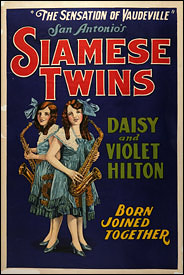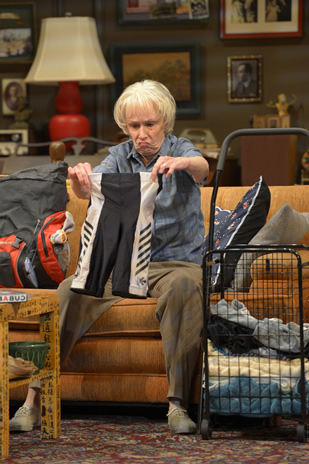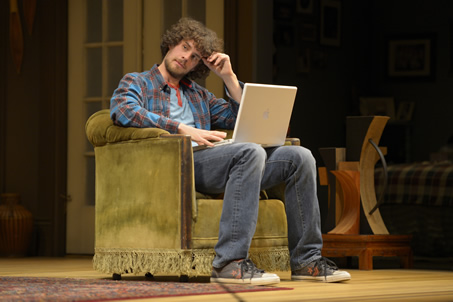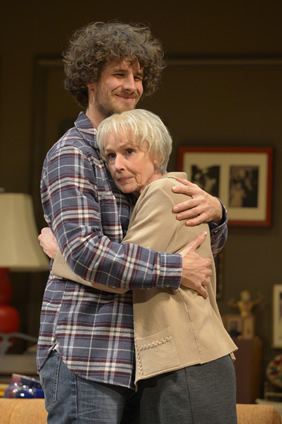Many years ago a friend of mine asked me why, when attending gay film festivals, he didn't see movies about people like himself and his lover. They were a happy couple, aging gracefully, living comfortably in suburbia, and blessed with a circle of loving friends. Why, he wanted to know, was he only seeing films about gay men who were suicidal drug abusers, liars, thieves, and whores?
I tried to explain that playwrights and filmmakers look for dramatic conflict as they try to highlight differences between their characters that might provoke tension and move a story forward. Although he and his lover were perfectly delightful people, compared to what producers and filmmakers were looking for, they were kind of boring. Think for a minute about the kinds of couples we see paired up on stage and screen:
- Some may be the best of friends (LaVerne & Shirley, Will & Grace) or the oddest of odd couples (Harold and Maude).
- Others may be partners in crime (Leopold and Loeb, Bonnie and Clyde) or dedicated to solving crimes and bringing criminals to justice (Cagney & Lacey, Scully and Mulder).
- Some may be partners of a questionable nature (Batman and Robin, Bialystock and Bloom, The Ambiguously Gay Duo).
- Others may be known for their artistic creations (Gilbert and Sullivan, Rodgers and Hammerstein).
- Occasionally one encounters a peculiar pair who represent opposite sides of a person's psyche (Dr. Jekyll and Mr. Hyde) or the two witches (Glinda and Elphaba) who are the lead characters in Wicked.
Whether these people are lovers, roommates, blood brothers, soul sisters, buddies taking a road trip, or friendly rivals, there is usually some kind of spark which adds tension to their moments together. Whether the bond between them is parasitic, comedic, sadistic, combative, or synergistic, each partner thrives in the other's presence.
It's easy to look at two friends (or lovers) who share a close rapport and wonder what attracts them to each other. But sometimes opposites not only attract, they can lead to the most unexpected kind of fame. Whenever you find yourself thinking that politics makes for strange bedfellows (James Carville and Mary Matalin), think about the more bizarre relationships that can be seen on stage and on screen.
- Some are obviously tragic (Romeo and Juliet).
- Some are comical (Timon and Pumbaa).
- Some involve a classic case of unrequited love (Clark Kent and Lois Lane).
- Some are situational (Rosencrantz and Guildenstern).
- Some simply defy categorization.
When two partners come from the same family, the results can vary widely. Conflict is easy to find in an unhappy marriage (Days of Wine and Roses, American Beauty, The War of the Roses, Who's Afraid of Virginia Woolf?) or in sibling rivalries (Twins, The Sisters Rosenzweig, Seven Brides for Seven Brothers, My Sister Eileen, Rain Man, Big Business). Dramatic conflict may be more difficult to manufacture in certain other situations.
Musical theatre fans are abuzz with reports that a new production of 1997's Side Show is in the works. A co-production between the La Jolla Playhouse and the John F. Kennedy Center for the Performing Arts, the show will premiere in La Jolla this fall and travel to the Kennedy Center's Eisenhower Theatre for a limited run in June of 2014. With music by Henry Krieger (Dreamgirls, The Tap Dance Kid, Lucky Duck) and book and lyrics by Bill Russell, Side Show tells the story of Daisy and Violet Hilton, two British-born conjoined twins who, after coming to America, became one of the highest paid acts in vaudeville history.
A new documentary about the Hilton sisters will be of vital interest to fans of Side Show. Bound By Flesh shows how the conjoined twins were abandoned at birth by their mother (an unmarried barmaid named Kate Skinner), who sold the girls to her boss and midwife, Mary Hilton.
Hilton took the girls on tour starting when they were three years old and, for much of their youth, they were the breadwinners in the family. The twins never saw any of the money they earned and were often abused by their step-parents. For a while they lived in San Antonio, Texas

Poster art for the Hilton Twins
Life was not always kind to the Hilton sisters. Although each twin had several love affairs (Daisy gave birth to an illegitimate child who was put up for adoption), most of their lives were spent in carnivals, circuses, freak shows, vaudeville, and burlesque.
Bound by Flesh stresses how rare it was in the early 20th century for conjoined twins to survive for very long after birth (the Hilton sisters died at the age of 60 after Daisy came down with the Hong Kong flu). Filmmaker Leslie Zemeckis has also done a great job of documenting what life along the lost world of the carnie/vaudeville circuit was like.
Of special interest is the interview with Ward Hall, formerly known as the "King of the Sideshow." Perhaps what is most fascinating is the archival footage of Daisy and Violet as they play the saxophone, go for a swim, and crabwalk toward the camera. Here's the trailer:
Whereas Daisy and Violet Hilton could not get away from each other, the lead characters in 4000 Miles are, in some ways, the most unlikely of roommates. The 70-year age gap between them is magnified by the differences in their vocabularies, philosophies, physical strength, and size.
Vera Joseph (Susan Blommaert) is a shrunken 91-year-old widow with memory problems who must rely on dentures and a hearing aid. A small, intelligent woman whose body has been twisted by old age, laundry has replaced politics and intellectual discourse as a big part of her life. Although Vera was given a computer by one of her children, no one in the family has made any effort to teach her how to use it.
Back in the day, Vera was an ardent Communist with a passion for progressive politics. One of the last surviving members of a group of octogenarians, she trades daily phone calls with an elderly neighbor across the hall in their Greenwich Village apartment building to make sure they're both still alive. Although their apartment doors are barely 10 feet apart, the two women hardly ever see each other. Ginny can be a real pain in the ass and Vera, as they say, has issues.

Susan Blommaert as Vera Joseph in 4000 Miles
Photo by: Kevin Berne
Vera's temporary roommate is her 21-year-old grandson, Leo (Reggie Gowland), who has just finished bicycling across the United States and arrived at 3:00 a.m. without any prior warning. Leo brings with him a bike, a backpack, a rather skewed sense of priorities, and a conscience of curious convenience that allows him to duck certain family and social responsibilities. Not having bathed in a while, he reeks of sweat and dirt but, being a dedicated locavore, won't accept a banana from his grandmother because it wasn't grown locally.
Leo's mother may be a real bitch, but there's a damned good reason she's worried about her son (who, after witnessing his best friend Micah get killed in a freak accident, got back on his bike the following day and continued down the highway). Like many young men Leo is directionless, quite self-centered, and not very skilled at managing his relationships with women. He also has absolutely no compunction about asking his grandmother for $50 so he can go rock climbing at a local gym. Although well intentioned, he can be a bit of a dick.

Reggie Gowland is Leo in 4000 Miles (Photo by: Kevin Berne)
While many are hailing Amy Herzog's new play for its bold writing and sharp characterizations, I thought it had the dramatic tension of a terrarium. The most rewarding feature of American Conservatory Theater's production (which marked the play's West Coast premiere) was Erik Flatmo's lovely unit set, which was gently lit by Alexander V. Nichols through a dozen or so scenes which play out like a series of piano ?tudes.
Although 4000 Miles was tenderly directed by Mark Rucker, it's hard to escape the feeling that one is staring at a diorama about life in a rent-controlled apartment. Leo makes up and breaks up with his girlfriend, Rebecca (Julia Lawler). On another night, he brings a Chinese art student (Camille Mana) back to Vera's apartment. While Amanda doesn't hesitate to acknowledge her basic sluttiness, she freaks out when Leo casually mentions that his grandmother used to be a Communist.

Leo (Reggie Gowland) and Vera (Susan Blommaert)
share a hug in 4000 Miles (Photo by: Kevin Berne)
The opening number of Kander & Ebb's 1968 musical, Zorba, stressed that "Life is what you do while you're waiting to die." While Leo is in no particular rush to organize his life, Ginny bites the dust before the play ends and Vera is obviously running out of time.
4000 Miles has the [almost obligatory] scene in which a rootless hipster gets high with his toothless bubbe. But overall, there's a lot less to Herzog's play than meets the ear.
To read more of George Heymont go to My Cultural Landscape
?
Follow George Heymont on Twitter: www.twitter.com/geoheymont
"; var coords = [-5, -72]; // display fb-bubble FloatingPrompt.embed(this, html, undefined, 'top', {fp_intersects:1, timeout_remove:2000,ignore_arrow: true, width:236, add_xy:coords, class_name: 'clear-overlay'}); });
Source: http://www.huffingtonpost.com/george-heymont/the-odd-couples_b_2730230.html
No comments:
Post a Comment